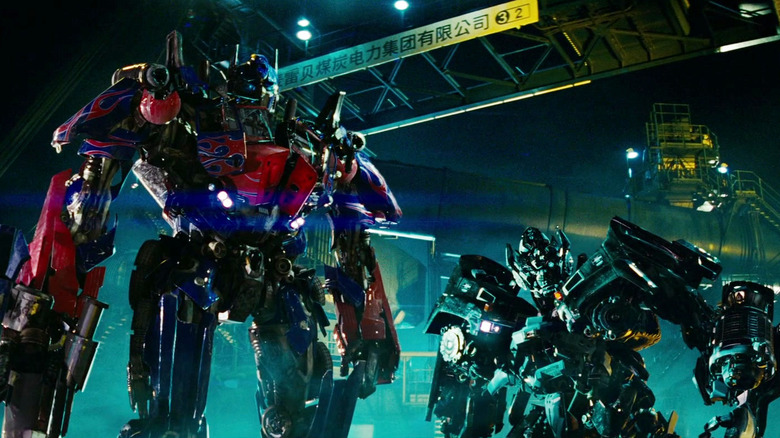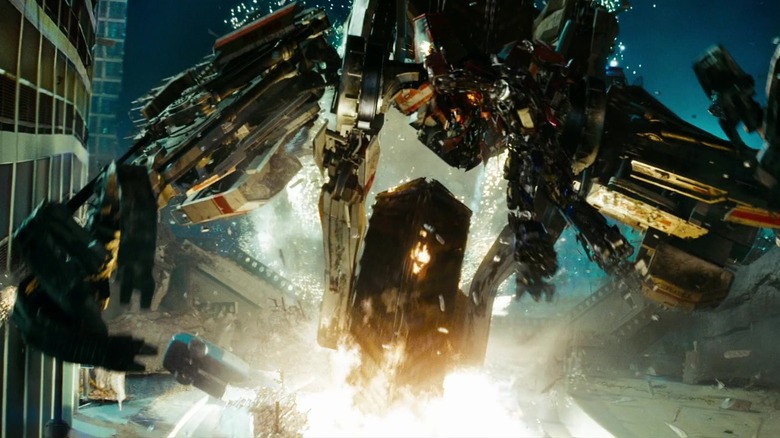Revenge Of The Fallen's First Scene Was A Trial By Fire For The Transformers Crew
The term "vulgar auteurism" was coined in the early 2010s to describe the work of low art big-budget filmmakers like Michael Bay. I've always felt it was a silly expression, myself. "Auteur" is a loaded word for reasons too complicated to get into here (for more on that, you should read BJ Colangelo's sublime take on the matter), but for me, "auteur" isn't necessarily synonymous with quality. It simply refers to a storyteller with a clear set of interests and fixations.
In Bay's case, he worships those who wear badges and uniforms for a living, and his craft involves a form of technical maximalism that's come to be known as "Bayhem." As Bay once put it while explaining his love of Robert Wise's classic 1961 musical "West Side Story," "It was all about form, style, how they use the medium. That's what I try to do with my action."
The opening to Bay's "Transformers: Revenge of the Fallen" is a perfect example of what he's talking about. Following a prologue that explains what "the Fallen" even is, the 2009 sequel jumps to Shanghai, as a joint task force of humans and Autobots (the heroic Transformers) take down a pair of renegade Decepticons (the dastardly Transformers). It's an utter cacophony of sound and images that, as the film's visual effects supervisor Scott Farrar revealed in a behind-the-scenes video, was actually shot at a closed-down steel mill in Bethlehem, Pennsylvania.
Given Bay's practical approach, it's not exactly shocking to learn this sequence was a proper trial by fire to realize. "The Bethlehem Steel scene, which is the opening of the movie effectively, was really, logistically, the biggest thing we had to do, I think," said director of photography Ben Seresin. "Certainly from my point of view. Three nights, massive night shoots."
'Michael's not that sort of guy'
Michael Bay doesn't do "small" and this particular sequence was no exception. According to Special Air Service Forces member Matthew Marsden, "I think at one time we had two Apache helicopters, two Blackhawk helicopters, and also two additional filming helicopters along with Humvees, Rangers. You know, I mean, it was just massive."
In an unconventional move, Bay elected to film this scene at the start of production. As Ben Seresin noted, most of the time directors prefer to start off with "something small to get people up to speed, help them to sort of acquaint themselves with each other, and generally help the process gently start. Michael's not that sort of guy." Bay concurred with this, stating:
"I like to start 'em hard and fast, very first week. Your first week on a movie sets the entire tone for the show. You wanna do a little bit of action, a little bit of character, a little bit of stuff that's gonna wow the studio, stuff that's going to test your lighting, that's going to establish a look. You try to do a little of everything so that it just sets the tone."
Perhaps the biggest problem with "Bayhem" (though definitely not the only one) is that it leaves no room for quieter moments. If things aren't going kablooey in most of Bay's films, then characters are frantically yelling or the camera is swooping wildly or striking dramatic angles. It works when the film is a feature-long chase like "Ambulance," but in a film like "Revenge of the Fallen," where nearly every scene is designed to overstimulate viewers, it just leaves you feeling exhausted.
Bay's collaborators know that feeling. As Marsden put it, "[...] I was finishing, I'm like, 'Man, you know what, I wish I was doing this 15 years ago, because I feel like an old man right now.'"

